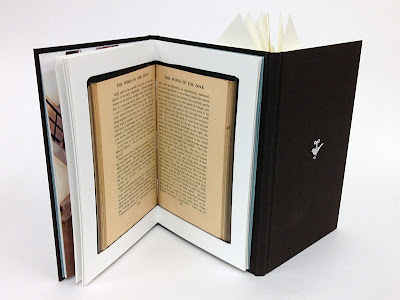Hybrid exegesis / Avian Titled Literature
 |
| THE BOOK SPOTTER'S GUIDE TO AVIAN TITLED LITERATURE. A HYBRID EXEGESIS. |
Last year, Kate Sweetapple and I created an installation for the UTS Library. We suspended 30 altered books in a 'flock' down the Library's central stairwell. Each book represents a novels with a bird in its title – One Flew Over a Cuckoo's Nest, To Kill a Mocking Bird, Flaubert's Parrot, Love Amongst the Chickens, The Eagle Has Landed, etc. To give the work context, we designed ten posters that were mounted on the stairwell wall. One poster is a Book Spotter's Guide to Avian Titled Literature; it lists the title, author and call number of each book in the flock, so library patrons can find the book on the shelves. The other posters are quotations taken from nine of the books – each poster displays a passage from the book where the titular bird is mentioned. These poster give a taste of the narrative prose of each book, and demonstrate how differently the way the birds are referenced in each book. We hope the posters will inspire patrons to check out the novels in the library, to remember that libraries are a space for search and discovery.
It is difficult to position design practice as research without explaining the context in which it came to be. Just as a researcher begins a scholarly article by positioning it in a particular field and referencing theory or texts she has drawn from, practitioner researchers must frame their creative practice for it to be understood as a research outcome. Where the writer takes a new idea and frames it in a theortecial context, a practitioner-researcher creates a new work, and tells the story of that work: what led to its creation, the process of creation and where it points the maker to next. It is this deliberate process of articulating the context, process and findings of a design project that constitutes a contribution to a field. Traditional scholarly journals are not always an appropriate forum to report practitioner research for several reasons. First, due to restricted space on the page and budget considerations, many journals do not accommodate large quantities of images that are necessary to explain a design process. Scholarly journals tend to prioritize written arguments over visual or verbal-visual arguments. Second, practitioner-researchers often do not produce creative work that is based on or framed by traditional scholarly theoretical frameworks, therefore finding reviewers for these submissions is difficult. Therefore, practitioner-researchers need to find alternative ways to disseminate their research, that accommodate verbal and visual arguments.
Accompanying the Avian Titled Literature installation, we produced a 'hybrid exegesis' called 'Field Guide to Avian Titled Literature. To clarify what 'hybrid exegesis' means, it is necessary to pick it apart.
Hybrid: I used the term 'hybrid book' in my doctoral thesis to describe novels in which graphic elements (photographs, drawings, diagrams) are integrated within the written text, as literary devices. These graphic devices are more than illustrations of the written text, they are an integral part of the text. You cannot remove them without significantly altering the primary text. 'Hybrid' gives a sense that word and image are grafted together to form an argument, rather than the image illustrating the text. Other examples where the terms 'hybrid book' or 'hybrid publication' are used to describe texts in which images form part of the primary text are Melville House's HybridBook project, where the core text of novels are 'illuminated' with digital material:
Exegesis: In universities and art schools, an exegesis is a written text in which the creative practitioner critically examines their work in light of contemporary theory and practice. This written exegesis often includes images that function as illustrations of the written argument. Although some exegesis may include images that form part of the argument, it is not an expectation of the genre of exegesis writing that this is the case.
By combining the terms, we are emphasizing that our research report is made through a combination of word and image. The images in the hybrid exegesis do more than offer illustrations of the written text, they form part of the argument.


Comments